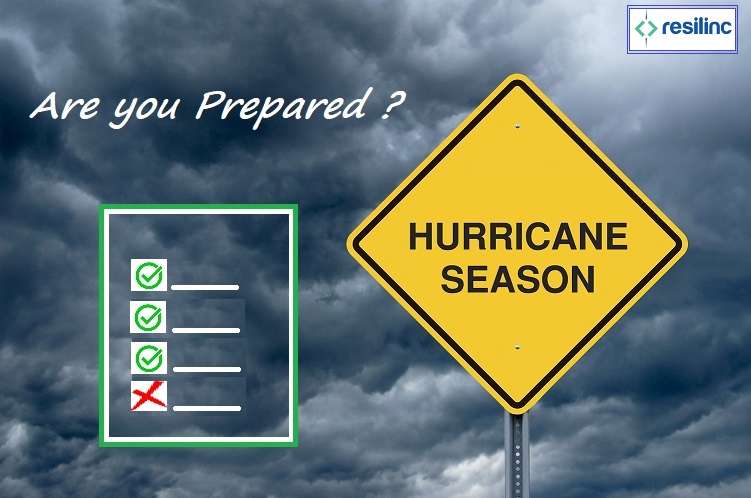Join the upcoming webinar by clicking here
The 2019 Atlantic hurricane season is underway, and the meteorological organization NOAA predicts a likely range of nine to fifteen named storms (winds of 39 mph or higher), of which four to eight could become hurricanes (winds of 74 mph or higher), including two to four major hurricanes (category 3, 4 or 5; with winds of 111 mph or higher).
The damage and disruption from 2017’s trio of hurricanes—Harvey, Irma and Maria, which together caused more than $200 billion in estimated losses—and hurricanes Florence and Michael in 2018 stand as warnings to supply chain professionals about the need to prepare in advance to manage potential disruptions from hurricanes this year—and every year.
To underscore the need for such proactive hurricane planning, Resilinc highlights some sobering statistics derived recently from its supply chain database: 27% of supplier sites lack business continuity procedures; 30% have no disaster recovery plan for their IT infrastructure; 37% have no backup power; 23% have poor fire & safety systems; and 35% have poor logistics recovery.
Making Preparation A Top Priority
From the point of supply chain manager or crisis manager, every organization should ensure that they are prepared in an organized structure for cross-functional planning, decision making, risk simulation, and quantitative effects on plans also called risk management planning. By evaluating the past effects of these storms and implementing risk management best practices, industry experts can apply lessons learned to better prepare for the future.
1. Multi-tier supply chain mapping down to the product and part-level
2. Supplier surveys and site readiness assessment
3. Dashboards incorporating analytics and automated recommendations
4. Ongoing monitoring throughout hurricane season featuring real time supplier impact confirmation during live events
What are The Preventive Steps for The Future ?
The “it is not going to affect us” is one of the most terrible standpoints to have, particularly when there are hard information and insights concerning hurricane and other weather-related impacts previously. However, many business leaders and SCM managers still are uncertain about how to take the right steps for hurricane season preparation. A powerful risk management plan with a climate-related risk management approach can give supply chain professionals the best alternatives to avoid losses in such disasters.
What to do :
Be aware — Keeping yourself up to date is the first step in prevention. If you are aware of the past events you must be knowing the risk of devastating weather impacts. Evaluate your risks, locations, and operations which can be of high-priority. Understand your worst-case and what-if scenarios, then prepare a plan for them to avoid disruptions. Fortunately, Resilinc clients leverage Eventwatch® AI to be notified of events immediately and respond to these threats in an automated manner.
Always have plan ‘B’ — By evaluating the events of the past always prepare an emergency plan covering factors such as alternative routes, risk, and opportunities to use in the path of potential disaster. Consider developing a list of additional suppliers, transportation providers, warehousing options, and more to use as a backup plan. Case in point, Biogen averted what could have costly delays in manufacturing due to shortages of supplies from plastics bags during Hurricane Maria (see Biogen case study). In the weeks after the immediate response to Maria, Biogen took action to begin dual-sourcing the single-source items that had been coming from Puerto Rico. They also decided to dual source off-the-shelf items as much as possible instead of items made to our specifications,
Leverage Technology for Coordination — Using AI-based technology, establishing coordination among your supply chain partners inside and outside your organization can help you a lot. Make sure that everyone is on the dashboards and understands your risk management plan. With efficient planning in place and by leveraging the technology, you can also improve your efforts. Today’s technology can help logistics professionals gain far greater visibility, providing real-time updates and actionable insights. The AI technology will not only notify you what is going on at every step in real-time related to supply chain but can also help you predict weather-related problems and give you the information you need to decide the best next steps mitigating challenges before they even become a problem. For example, Biogen also used its management of Maria and the other disasters as launching pads for cross-functional playbooks to be incorporated at the company level within Resilinc, and as a reference for future disasters. “The goal is for it to be system dependent, not person-dependent,” said Lee Spach, Director, Global Product and Supply Chain Security, Biogen. “The Resilinc system is a great place to curate the playbook so whoever comes along in future can see what we did with Maria.”
As the hurricane season moves toward the peak activity weeks of late August and early September, hurricane watchers will be keeping a close eye on the strength of the El Niño phenomenon, a significant factor in the vastly complex global weather patterns that determine Atlantic hurricane activity. In the midst of such complexity and uncertainty, Resilinc recommends supply chain managers focus on what they can control: understanding the levels of risk embedded in their supply chains and taking advance steps to mitigate those risks.
If you want to learn best practices for proactive hurricane preparedness using advanced AI and Data Science technology to avoid millions in potential losses and lower your risk exposure to hurricanes and typhoons globally Register and attend the webinar on the topic “Using AI for Supply Chain Hurricane Preparedness”.
For more information and to watch the webinar, register here





